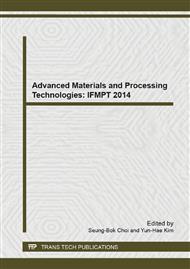p.316
p.320
p.327
p.333
p.337
p.344
p.348
p.352
p.357
Influence of Raw Material Concentration on Product Characterization of Magnesium Hydroxide Prepared via Ammonia Method
Abstract:
Magnesium hydroxide was prepared through direct precipitation using magnesium chloride and ammonia as raw materials. In this paper, we mainly studied the effects of magnesium hydroxide on product characterization when the concentration of raw materials was changed. The products were characterized through laser light particle size analysis, scan electron microscope and X-ray diffraction. The study showed that a sudden change in the morphology of magnesium hydroxide products and in the polarity of the crystal occurred under the following conditions: stirring speed of 2500 rpm, reaction temperature of 60°C, ammonia to magnesium chloride ratio of 2:1, ammonia addition rate of 20 mL/min, and aging time of 30 min. As the raw material concentration was changed, the morphology of magnesium hydroxide products and the polarity of the crystal exhibited sudden change. When the concentration of magnesium chloride was changed to 0.8 mol/L, the product demonstrated a flower-like globular structure, the largest size, and the minimum polarity. When the concentration of magnesium chloride was more than 1 mol/L, the product exhibited a flake structure, no obvious aggregation and a narrow particle size distribution.
Info:
Periodical:
Pages:
337-343
Citation:
Online since:
February 2014
Authors:
Keywords:
Price:
Сopyright:
© 2014 Trans Tech Publications Ltd. All Rights Reserved
Share:
Citation:


